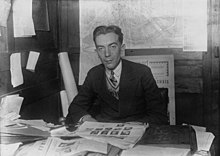https://www.facebook.com/hanching.chung/videos/760745451977738
《九彎十八拐》雙月刊第108期 2023.3.1。讀黃春明說故事 《謝謝白髮老館長 》和地方廣告文案、Marcel Aymé 馬塞爾·埃梅 1902年 - 1967年《穿牆人》(Le passe-muraille)1943丁樹南1923 ~2009 譯。
「歐坦生」/「丁樹南」1923 ~2009。Marcel Aymé 1902年 - 1967年馬塞爾·埃梅《穿牆人》(Le passe-muraille)1943
***
賀《九彎十八拐》雙月刊第100期
https://www.facebook.com/hanching.chung/videos/853886745282290
-----
https://www.facebook.com/hanching.chung/videos/1054243651986554
《九彎十八拐》第 98期
讀《九彎十八拐》雙月刊第98期 (疫情下,2021.8):曹永洋、黃春明、宣誠 (賀柏爾短篇選Hebel )、王尚義 (墓碑小詩、野鴿的黃昏)、張曉風 (唸你們的名字))、【羅丹的轉型:巴爾札克雕像的故事】—(奚淞:孩子,我在未來的街頭等你)......
.....
馬塞爾·埃梅(法語:Marcel Aymé,1902年3月29日-1967年10月14日)法國二十世紀小說家、兒童作家,劇作家,創作有眾多短篇小說,生於約訥省茹瓦尼,曾在巴黎做過記者。1926年發表處女作,《死者的高地》(La Table aux crevés)獲得勒諾陀獎,1933年創作《綠色的母馬》,大獲成功,並被翻譯為英語。此後開始專注創作和發表兒童故事、小說和故事集。1935年還開始寫電影劇本,1943年發表《穿牆人》(Le passe-muraille),1950年發表《七里靴》(Les Bottes de sept lieues)。
外部連結[編輯]
| 維基共享資源中相關的多媒體資源:馬塞爾·埃梅 |
記念碑[編集]
エイメの作品は数多くの映画、テレビ、さらには新聞の漫画などに影響を与えた。
パリに行くと、モンマルトルの一角にあるマルセル・エイメ広場に、彼を顕彰する記念碑を見ることが出来る。そこにはエイメの掌品・『壁抜け男』に由来する彫像が建てられている。

Le Passe-muraille (statue place Marcel-Aymé).
主要作品[編集]
※太字は邦訳(全訳)有り。邦訳のある作品については初訳時の邦題を採用した。
小説[編集]
- Brûlebois (ブリュールボア) 1926年
- La Table-aux-Crevés (飢えた人々の食卓) 1929年
- La Rue sans nom (名前のない通り) 1930年
- La jument verte (緑の牝馬) 1933年
- Le Nain (こびと) 1934年 短編集
- Maison basse (低い家) 1935年
- Derrière chez Martin (人生斜断記) 1938年 短編集
- La Belle Image (第二の顔) 1941年
- Travelingue 1941年
- Le passe-muraille (壁抜け男)1943年 短編集
- Le Chemin des écoliers (学生たちの道) 1946年
- Le Vin de Paris (パリの葡萄酒) 1947年 短編集
- Uranus (天王星) 1948年「ウラヌス」
- En Arriere(後退) 1950年 短編集
随筆[編集]
- Le Confort intellectuel (インテリ安泰) 1949年
戯曲[編集]
- Lucienne et le boucher (リュシエンヌと肉屋) 1947年
- Clérambard (クレランバール) 1950年
- La Tête des autres (他人の首) 1952年
- Les oiseaux de lune (月の小鳥たち) 1956年
童話[編集]
- Les contes du chat perché (おにごっこ物語)
日本編集アンソロジー[編集]
- 壁抜け男 (Le Passe-muraille) 選・訳/中村真一郎 早川書房〈異色作家短篇集〉 1963年、早川書房、改訂版1976年、新版・2007年、※6編の短編集
- 「クールな男」 (L'indifférent) 選・訳/露崎俊和 福武文庫、1990年
- 新版「マルセル・エメ傑作短編集」 中公文庫 2005年、※7篇の短編集
- 壁抜け男 (Le Passe-muraille) 選・訳/長島良三 角川文庫 2000年
***
馬各/ 丁樹南/ 編. 出版社, 爾雅出版社有限公司. 商品描述, 五十五年短篇小說選:
Maren Elwood, 丁樹南. 文星書店, 1967 - 218 pages.
《經驗的河流》丁樹南譯,大地
小小說的寫作與欣賞- 丁樹南- Google Books
Bibliographic information ; Author, 丁樹南 ; Publisher, 純文學月刊社, 1967 ;177 pages ;
純文學短篇小說選譯,純文學出版社, 1980
----
culture.tw
https://nrch.culture.tw › twpedia
歐坦生. 小說家、評論家。筆名丁樹南、平山、江上秋等。中國福建福州人。中國國立暨南大學福建建陽分校畢業,1947年來臺。任國小校長及中學教師近40年至退休。
辭世作家 - 台灣文學館
nmtl.gov.tw
http://activityfile.nmtl.gov.tw › Volume_2009
PDF
丁樹南,男,本名歐坦生,另有筆名平. 山、羅笛、異風、江上秋,1923年8月7日生,. 籍貫中國福建省福州市。丁樹南畢業於暨南大. 學福建建陽分校,曾任福州《粹報》編輯 ...
NTU Scholars
臺灣文學研究所
請用此 Handle URI 來引用此文件: https://scholars.lib.ntu.edu.tw/handle/123456789/29517
標題: 斷裂與繼承:從「歐坦生」到「丁樹南」作品研究
Dissolution and Inheritance:A Study On Ou Tan-Sheng and His Works
作者: 王萌
Wang, Meng
關鍵字: 歐坦生;丁樹南;現實主義;寫作理論;翻譯;Ou Tan-Sheng;Ding Shu-Nan;Realism;Translation;Writing Theory
公開日期: 2016
摘要:
本文以戰後初期渡海來台的作家歐坦生及為研究對象,探討其人從福州到台灣的創作樣態。出生於福州的歐坦生,中學時期開始文學創作,在嘗試不同文體後最終走向最為擅長的小說創作。福州時期,他受到戰爭氛圍與國統區的影響,逐步確立現實主義的創作理念,以小說作品關照社會,擅長刻畫小人物與諷刺的風格,具有社會批判與人文關懷色彩,並將這種風格延續至來台後的創作。1947年歐坦生赴台後立即創作了反映戰後初期台灣社會現實的小說作品,被楊逵稱之為台灣新文學的好樣本。歐坦生的小說創作也與戰後初期台灣文壇中有關如何建設台灣新文學的討論相呼應,具體實踐了如何以現實主義創作反映台灣的「一般性」與「特殊性」。進入1950年代,台灣文壇受到國家機器的高度控制,創作自由受到限制,歐坦生改以丁樹南為筆名發表作品,意欲堅持其現實主義小說創作,但只能收起作品中的社會批判與諷刺意味,改而專注於描繪日常生活中小人物的悲歡離合。1960年代開始,歐坦生逐漸收起小說創作的道路,轉向寫作理論翻譯與文藝評論的活動,翻譯一系列針對寫作初學者的寫作理論與技巧,並最早在台灣文壇提倡「小小說」這一文體。 大抵,本文透過梳理歐坦生生命經歷與文學活動,建構其人從福州到台灣完整的創作樣貌。一方面,在縱向緯度上,考察歐坦生一生的文學活動軌跡,以期探討在時代與空間的變動中作家如何堅持並實踐自己的文學理念;在橫向緯度,則將其放置於各個時空的文學場域中,考察其如何主動或被迫地不斷調整以適應文學場域的變化。另一方面本文則是透過歐坦生其人其作,折射出戰後台灣文學史曲折多變的光影。
This thesis focuses on Ou Tan-Sheng, who went across the sea to Taiwan from Fuzhou in the early stage of post-war, and his works. Ou Tan-Sheng (1923-2009) was born in Fuzhou. When he was 14 years old, Ou started writing. After trying different types of literature, Ou Tan-Sheng decided to establish novel as his main form of creative writing. In Fuzhou Period, the novelist was influenced by the social environment of KMT Ruling Area and began to establish the concept of the Realism in his works. As a result, the vivid depiction of average persons and the unique style of sarcasm were throughout this period, and all these characteristics were also the main branch of novel creation in the first few years after he settled in Taiwan. In 1947, Ou instantly finished several novels reflecting the social reality of Taiwan, and these works was called “the good samples of Taiwan Literature” by Yang Kui. In addition, through these novels creation, Ou responded the discussion about how to build the Taiwanese new literature in the literary circles of Taiwan, and did the concrete practices about how to reflect the universality and the particularity of Taiwan. In 1950''s, as the government increased the mind control of cultural community, Ou Tan-Sheng’s creation was restricted. As a kind of coping method, he used Ding Shu-Nan as his pseudonym, but he also tried to concentrate more on the depiction of joys and sorrows of ordinary people than social critique and sarcasm style. Then, Ou stopped writing novels and turned to translate the writing skills in 1960''s, and he is the first one who translated and introduced the short short story theory into Taiwan literary field. Therefore, through collecting and analyzing his experiences and works, this thesis aims to locate Ou Tan-Sheng and his works in Taiwan literary history, and bring this less-studied figure into the field of literary studies. On one hand, this thesis investigates the track of his whole life and literary activities, to find out the inheritance and changes of his works. On the other hand, this thesis also puts Ou Tan-Sheng and his works into different kinds of the cultural fields, to understand his adjustment and persistence for the change of literary field.





沒有留言:
張貼留言